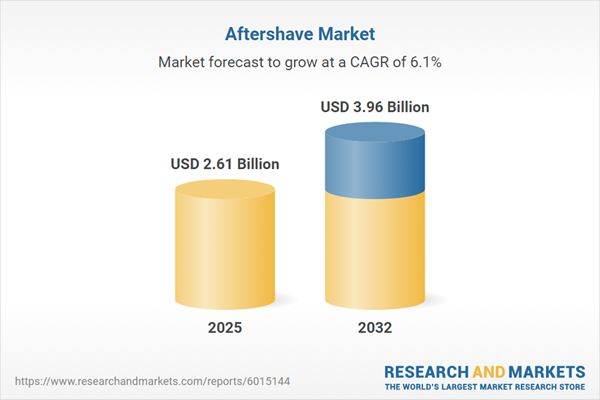Speak directly to the analyst to clarify any post sales queries you may have.
The aftershave market is navigating a pivotal transformation as consumer expectations shift toward personalized, high-performance, and sustainable products within grooming routines. Industry participants must now address evolving definitions of efficacy, sensory appeal, and ethical production to secure lasting business growth.
Market Snapshot: Aftershave Market Size & Growth Outlook
The global aftershave market grew from USD 2.46 billion in 2024 to USD 2.61 billion in 2025. Sustaining momentum, the market is projected to expand at a CAGR of 6.10%, reaching USD 3.96 billion by 2032. This progression reflects expanding grooming habits, continued product innovation, and strong demand across diverse demographic and geographic segments.
Scope & Segmentation: Full View of the Aftershave Market
This study delivers an in-depth analysis of the aftershave market, segmented for clarity and actionable insight.
- End User: Men and Unisex segments highlight both classic male-focused products and inclusive formulations with universal appeal.
- Formulation: Alcohol Based, Alcohol Free (Scented and Unscented), and Organic options (Certified Organic and products derived from Natural Extracts) reflect rising demand for customized skin compatibility and regulatory compliance.
- Product Type: Includes Balms, Gels, Lotions, and Splashes, catering to varying hydration, absorption, and ritual preferences among consumers.
- Price Tier: Economy, Luxury, Mid Range, and Premium offerings address diverse buyer priorities, from value-driven shoppers to those seeking artisanal packaging or exclusive fragrance blends.
- Distribution Channel: Online Retail (Direct To Consumer and Third Party Ecommerce), Pharmacy, Specialty Store, and Supermarket/Hypermarket support both digital and offline presences, ensuring comprehensive market access.
- Scent Type: Aquatic, Citrus, Floral, Oriental, and Woody fragrances help brands address consumer desire for sensorial variety and signature experiences.
- Regional Coverage:
- Americas: North America (United States, Canada, Mexico) and Latin America (Brazil, Argentina, Chile, Colombia, Peru).
- Europe, Middle East & Africa: Includes UK, Germany, France, Russia, Italy, Spain, Netherlands, Sweden, Poland, Switzerland, UAE, Saudi Arabia, Qatar, Turkey, Israel, South Africa, Nigeria, Egypt, Kenya.
- Asia-Pacific: China, India, Japan, Australia, South Korea, Indonesia, Thailand, Malaysia, Singapore, Taiwan.
- Leading Companies: Analyzed entities include The Procter & Gamble Company, Unilever PLC, Beiersdorf AG, L'Oréal S.A., Coty Inc., Shiseido Company Ltd., The Estée Lauder Companies Inc., Edgewell Personal Care Company, LVMH, and Puig Corporación Empresarial.
Key Takeaways for Strategic Decision-Makers
- Aftershave products have shifted from simple disinfectants to advanced, multifunctional solutions delivering both performance and sensory benefits.
- Innovation stems from developments in ingredient science, fragrance complexity, and product texture, supporting consumer preferences for tailored experiences.
- Sustainability is central, with a marked rise in demand for eco-friendly packaging, transparent sourcing, and regulatory adherence across formulation and distribution strategies.
- Digital transformation is reshaping both consumer engagement and product distribution, as personalization platforms and direct-to-consumer models gain ground.
- Regional distinctions drive divergent growth, with premium product interest prevailing in select markets while affordability or wellness certifications support uptake elsewhere.
- Industry leaders are leveraging cross-sector partnerships and technological advances to accelerate product development and enhance market relevance.
Impact of United States Tariff Measures
Recent US tariff adjustments have altered cost structures for imported ingredients such as botanical extracts and specialized glass packaging. Brands have responded through local sourcing, pricing recalibration, and logistical optimizations. These adaptations are designed to improve supply chain resilience and maintain value across consumer offerings.
Methodology & Data Sources
This report utilizes a mixed-methods research framework including literature reviews, expert interviews with scientists and executives, and data extracted from proprietary databases and retail sales trackers. Data cleansing and expert consensus ensure accuracy across regional analysis and strategic projections.
Why This Report Matters
- Enables senior executives to anticipate shifts in grooming culture, technology adoption, and sustainability practices, shaping informed investment decisions.
- Helps brands align product portfolios with fast-changing consumer expectations and regulatory trends for competitive advantage.
- Equips stakeholders to navigate tariffs and supply chain complexities efficiently, supporting uninterrupted product availability and pricing stability.
Conclusion: Navigating Market Evolution
Business success in the aftershave market depends on agile adaptation to evolving consumer behaviors and technological innovations. This strategic report provides the guidance stakeholders need to secure relevance and growth in a rapidly advancing grooming sector.
Additional Product Information:
- Purchase of this report includes 1 year online access with quarterly updates.
- This report can be updated on request. Please contact our Customer Experience team using the Ask a Question widget on our website.
Table of Contents
3. Executive Summary
4. Market Overview
7. Cumulative Impact of Artificial Intelligence 2025
Companies Mentioned
The companies profiled in this Aftershave market report include:- The Procter & Gamble Company
- Unilever PLC
- Beiersdorf AG
- L'Oréal S.A.
- Coty Inc.
- Shiseido Company, Limited
- The Estée Lauder Companies Inc.
- Edgewell Personal Care Company
- LVMH Moët Hennessy Louis Vuitton SE
- Puig Corporación Empresarial, S.L.
Table Information
| Report Attribute | Details |
|---|---|
| No. of Pages | 181 |
| Published | October 2025 |
| Forecast Period | 2025 - 2032 |
| Estimated Market Value ( USD | $ 2.61 Billion |
| Forecasted Market Value ( USD | $ 3.96 Billion |
| Compound Annual Growth Rate | 6.1% |
| Regions Covered | Global |
| No. of Companies Mentioned | 11 |









